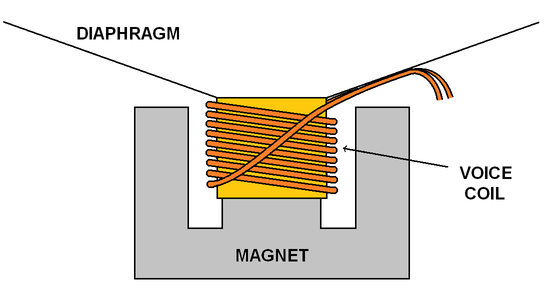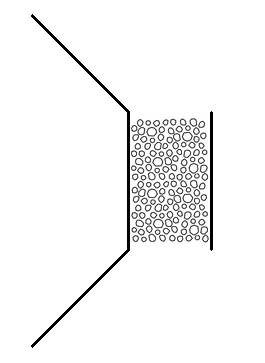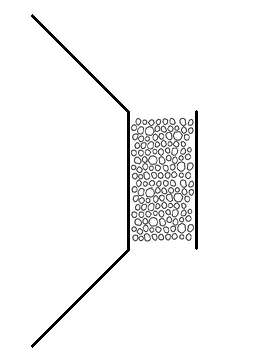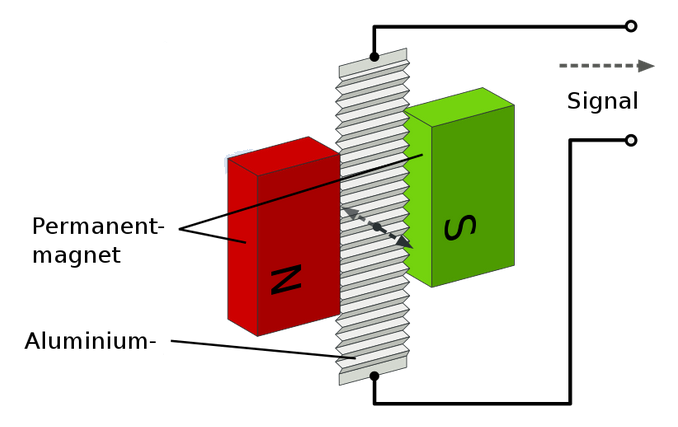| Vocademy |
Microphones
A microphone is a device that converts sound waves into electrical signals. A microphone, depending on its construction, converts sound waves into varying electrical currents or voltages or presents a variable resistance.
A typical microphone consists of a diaphragm that couples the microphone to the air. Sound waves in the air cause this diaphragm to vibrate. This vibration is coupled to a device that converts the vibrations into an electrical signal as stated above.
Types of microphones
Dynamic microphone
 |
| The voice coil is wound on a spool attached to a diaphragm. When sound vibrates the diaphragm the voice coil moves in the magnetic field producing "sound shaped current." |
The diaphragm of a dynamic microphone is attached to a spool of fine wire. This spool is held in a circular groove manufactured into a powerful magnet. The coils of wire on the spool are oriented perpendicular to the magnetic field. When sound causes the diaphragm to move this spool of wire moves with it. When the spool of wire moves in the magnetic field, current is produced in the wire. When the diaphragm and spool move outward, the current moves one way and when they move inward the current moves in the opposite direction. This produces alternating current with frequencies identical to the sound frequencies and amplitudes proportional to the sound amplitude. Alexander Bell called this current "voice-shaped current."
A dynamic microphone also works in reverse. That is, it will also act as a speaker. See the dynamic loudspeaker below.
Carbon microphone
 |
| Carbon granules in a carbon microphone |
 |
| Sound pressure on the diaphragm pushes carbon granules closer together decreasing the resistance. |
A carbon microphone has a capsule of carbon granules pressed between two metal plates. When the diaphragm vibrates, it alternately compresses and decompresses the carbon. When the carbon granules are compressed, they have less resistance and when uncompressed they have more resistance. This makes the carbon microphone a sound-actuated variable resistor. A voltage is applied across the carbon capsule via the metal plates and the current varies with the sound waves as the resistance varies.
The carbon microphone can also be used as an amplifier. A small change in pressure on the carbon granules makes a large change in the resistance and a correspondingly large change in the circuit current. A carbon microphone-amplifier essentially couples a dynamic speaker directly to the carbon microphone. This device was used in early long-distance telephone circuits before the vacuum tube amplifier was developed.
Ribbon microphones
The ribbon microphone may be the best known professional microphone. It consists of a lightweight corrigated aluminum ribbon suspended between the poles of a permanent magnet. The ribbon vibrates as sound waves encounter it, causing a small ac current as the ribbon vibrates in the magnetic field.
 |
| Principle of a ribbon microphone |
Ribbon microphones can be recognized by the large size of their protective screen.
 |
| A ribbon microphone with pop screen |
Piezoelectric microphone
A piezoelectric microphone or crystal microphone works by the piezoelectric effect. When the crystal is distorted, a voltage is developed across the crystal. This voltage is picked up by metal plates sandwiching the crystal. Sound waves are carried by a diaphragm to the crystal causing the crystal to vibrate and thus produce a varying voltage proportional to the frequency and amplitude of the sound waves.
The piezoelectric microphone cannot deliver high current and therefore has a high impedance.
Like the dynamic microphone, the piezoelectric microphone works in reverse. A varying voltage across the crystal caused the crystal to vibrate. See the piezoelectric earphone below.
Condenser microphone
"Condenser" is an archaic name for the capacitor. The diaphragm of a condenser microphone makes up one plate of a capacitor. This capacitor is charged to a given voltage. When sound waves cause the diaphragm to vibrate, there is a corresponding change in capacitance. When the capacitance is lower, the voltage increases. When the capacitance is higher, the voltage decreases. Therefore, as the diaphragm vibrates the voltage varies proportionally to the frequency and amplitude of the sound waves.
An electret condenser microphone uses a material with a permanent electric charge to supply the voltage for the capacitor.
Condenser microphones are widely used because of their high quality and small size.
Fiber optic microphone
A fiber optic microphone converts acoustic waves into electrical signals by sensing changes in light intensity, instead of sensing changes in capacitance or magnetic fields as with conventional microphones.
During operation, light from a laser source travels through an optical fiber to illuminate the surface of a tiny, sound-sensitive reflective diaphragm. Sound causes the diaphragm to vibrate, thereby minutely changing the intensity of the light it reflects. The modulated light is transmitted over a second optical fiber to a photodetector, which transforms the intensity-modulated light into analog or digital audio for transmission or recording. Fiber optic microphones have high dynamic and frequency range, similar to the best high fidelity conventional microphones.
Fiber optic microphones do not react to or influence any electrical, magnetic, electrostatic or radioactive fields. The fiber optic microphone design is therefore ideal for use in areas where conventional microphones are ineffective or dangerous, such as inside industrial turbines or in magnetic resonance imaging (MRI) equipment environments.
Fiber optic microphones are robust, resistant to environmental changes in heat and moisture, and can be produced for any directionality or impedance matching. The distance between the microphone's light source and its photodetector may be up to several kilometers without the need for any preamplifier or other electrical devices, making fiber optic microphones suitable for industrial and surveillance acoustic monitoring.
Fiber optic microphones are used in specific application areas such as for infrasound monitoring and noise-canceling. They have proven especially useful in medical applications, such as allowing radiologists, staff and patients within the powerful and noisy magnetic field to converse normally, inside the MRI suites as well as in remote control rooms.) Other uses include industrial equipment monitoring and sensing, audio calibration and measurement, high-fidelity recording and law enforcement.
Microphone Development and Types
| Vocademy |